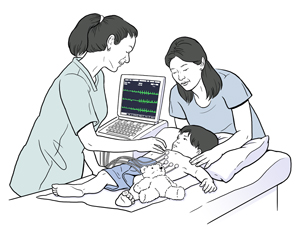Your Child's Echocardiogram
What is an echocardiogram?
An echocardiogram is an imaging test that uses sound waves (ultrasound) to create pictures of the heart.
Transthoracic echocardiography (TTE) is an echocardiogram that is done by passing an ultrasound probe (transducer) over the child's chest. This test can show problems with heart structure or function. This includes showing patterns of blood flow, how well the heart pumps, if the heart is enlarged, or if there is fluid surrounding the heart.
Transesophageal echocardiography (TEE) is similar to a TTE, but it’s done by passing the transducer into the esophagus (food pipe). Because the esophagus lies just behind the heart, a TEE usually gives clearer pictures than a TTE taken from outside the chest. Sedation is used for a TEE.
 |
| With a TTE, a transducer is moved across your child’s chest to take pictures of the heart. |
Why might my child need an echocardiogram?
Your child's healthcare provider may request an echocardiogram to:
-
Evaluate a heart defect
-
Check the structure and function of the heart
-
Check the structure and function of the heart valves
-
Check to see if the heart is enlarged
-
Evaluate the patterns of blood flow
-
Check how well the heart pumps
-
Check if there is fluid surrounding the heart
How do we get ready for a TEE?
You’ll be told whether to keep your child from eating or drinking anything for a certain amount of time before the test. Follow these instructions carefully.
How to help your child prepare
You can help your child by preparing them in advance. How you do this depends on your child’s needs.
-
Explain the test to your child in brief and simple terms. Younger children have shorter attention spans, so do this shortly before the test. Older children can be given more time to understand the test in advance.
-
Make sure your child understands which body part(s) will be involved in the test.
-
As best you can, describe how the test will feel. For a TEE with sedation, an IV (intravenous) line may be inserted into the arm or hand to give medicine to help them relax. This may cause a brief sting. Your child won’t feel any discomfort once the medicine takes effect.
-
Let your child ask questions and answer these questions truthfully. Your child may feel nervous or afraid. They may even cry. Let your child know that you’ll be in the room, or nearby, during the test.
-
Use the hospital services. Many hospitals have a child life specialist. This person is specially trained to help children understand what to expect during their time in the hospital. Books, videos, dolls, and toys may be used to help explain the procedure to your child. Be sure to ask your child’s healthcare provider about the resources available at your hospital.
What to tell the technologist or healthcare provider
Tell the technologist or healthcare provider if your child:
What happens during TTE or TEE?
TTE is usually done by a technologist and interpreted by a specially trained cardiologist. For a TEE, the cardiologist both performs the procedure and interprets the results. A cardiologist is a doctor who can diagnose and treat heart problems. The tests take place in a hospital. TTEs and TEEs last about 30 to 60 minutes.
-
Ask your child’s healthcare provider if you can stay with your child during the test.
-
For TTE, your child lies on an exam table with their shirt off.
-
If your child is having a TEE, they are given a pain reliever and a medicine that makes them relax or sleep (sedative). This is done by mouth or an IV line. Or your child is given medicine that makes your child sleep and not feel pain (anesthesia). This is done by face mask or IV. If your child is having a TTE, these medicines are rarely used.
-
For a TEE, a breathing tube may be placed in your child’s windpipe (trachea). Special equipment monitors your child’s heart rate, blood pressure, and blood oxygen levels.
-
During a TTE, clear, non-greasy gel is applied to your child’s skin. Then, the healthcare provider moves a small probe (transducer) across the chest. This device creates the sound waves that form pictures of your child’s heart on a video screen.
-
During a TEE, a long, flexible wand with a probe (transducer) on the end is used to take pictures of your child’s heart. First, your child’s throat is numbed. The wand is lubricated to allow it to slide easily. Then, it is guided down the throat into the esophagus. The healthcare provider moves the wand up, down, and sideways to look at your child’s heart from different angles. As with a TTE, images of your child’s heart are viewed on a screen.
What are the risks and possible complications of TEE?
-
Reaction to sedative or anesthesia
-
Sore throat or problems swallowing
-
Injury to teeth, mouth, esophagus, or stomach (rare)
What happens after TTE or TEE?
-
If a sedative or anesthesia was given, your child is taken to a recovery room. It may take 1 to 2 hours for medicines to wear off.
-
Unless told not to, your child can return to their normal routine and diet right away.
-
After TEE, your child’s throat may be sore. If the throat was numbed, your child will need to be careful when eating for a few hours.
-
The healthcare provider may discuss early results with you right after the test. You’ll get complete results when the images have been fully looked at.
When should I call my child's healthcare provider?
Call the healthcare provider if your child has: